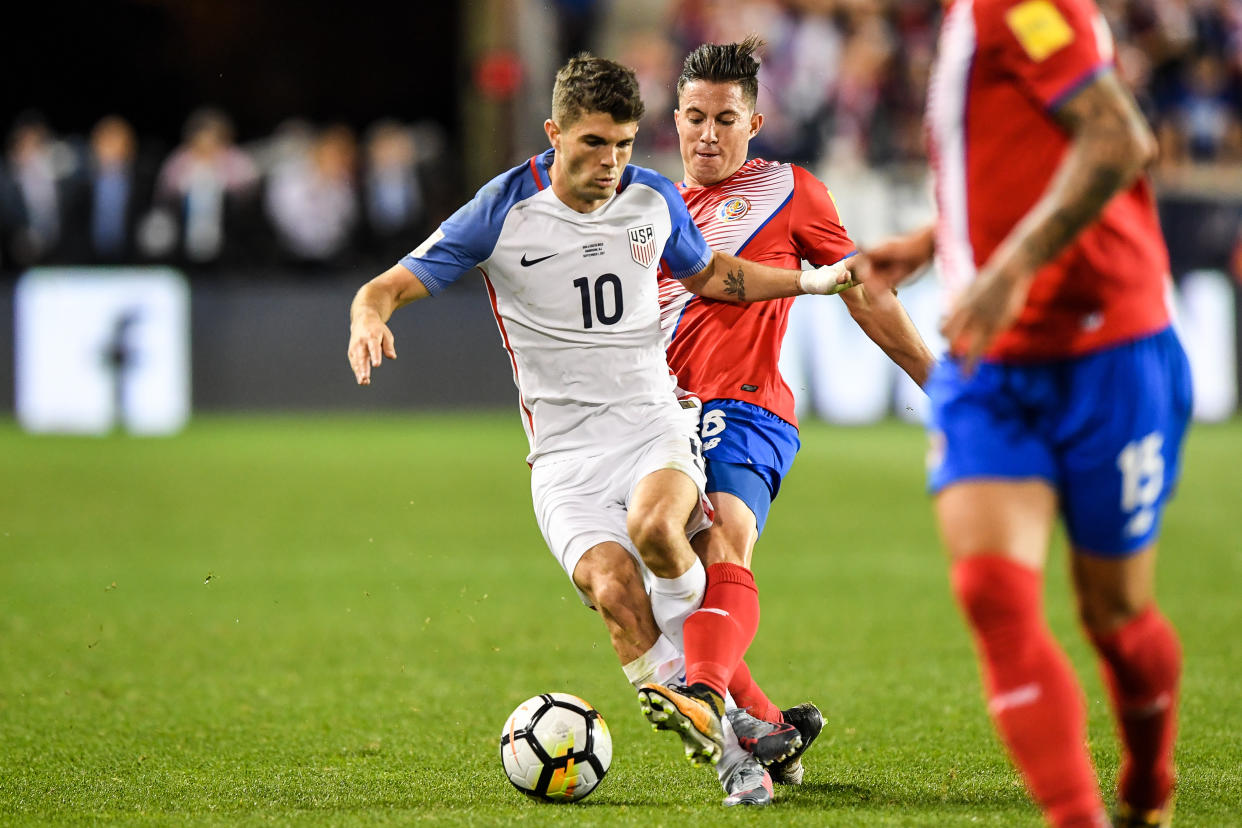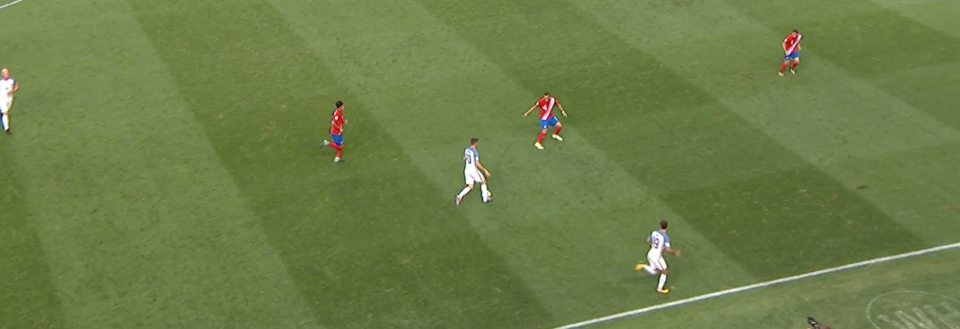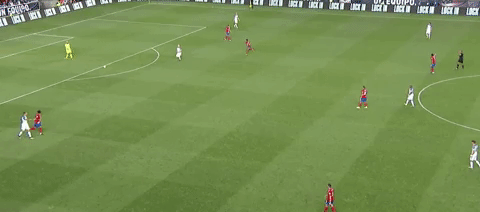Christian Pulisic, his Costa Rica frustration, and the next stage of his development

With every hack or whack to the shins, and with every tumble to the Red Bull Arena turf, pain seeped into Christian Pulisic’s face. In the 9th minute, it was absent. In the 13th, it simmered. In the 44th, it boiled, and by the midway point of the second-half, it conveyed full-on exasperation.
Pulisic had a rough Friday night in New Jersey, and it wasn’t just the bumps and bruises. For every one of them, there was a heavy touch; a shanked shot; a teammate’s pass gone astray. And for every one of those, there was a closed-off passing lane; a bracketing double-team; a defender right on his back.
Pulisic had arguably his worst game in a U.S. jersey in a 2-0 World Cup qualifying loss to Costa Rica, and his struggles were far from coincidental. Costa Rica paid the 18-year-old phenom as much attention as any opponent he’s encountered at the professional or full-international level. Manager Oscar Ramirez made Pulisic the focal point of his gameplan, and by doing so stemmed the flow of the American attack.
But the Costa Ricans also might as well have shed light on Pulisic’s potential path to superstardom. Because for as talented and effective as the U.S. youngster already is, the pro games he’s played as his team’s undisputed catalyst can be counted on two hands, if not one. And while a player of Pulisic’s caliber is already extremely rare, a player who can still be that catalyst while monopolizing an opponent’s attention is even rarer.
Costa Rica demonstrated that Pulisic probably isn’t that player just yet. That’s not to say he can’t become one. Again, he’s only 18. But there will be growing pains. Friday was full of them.
The center of Costa Rican attention
Toss aside formations, and positioning, and X’s and O’s. The leading examples of Costa Rica’s Pulisic focus were individual moments. The Ticos had clearly been drilled on how dangerous he is. So whether or not they were set, whether in transition or during sustained U.S. possession, they flocked to Pulisic.
In the 13th minute, even after the American winger turned Bryan Ruiz inside out, Costa Rica had cover:

Whenever Pulisic had the ball at his feet facing the Costa Rican goal, he almost invariably had two players to contend with. Here’s David Guzman in the 17th minute, his eyes honed in on Pulisic’s feet, his right hand pointing to where Christian Bolaños needed to be as a secondary defender:

Oftentimes that secondary defender arrived even before a pass destined for Pulisic did. For example, if Geoff Cameron sprayed the ball wide to Graham Zusi with Pulisic tucked infield, the Costa Ricans converged not on the ball, but on the possibility of a subsequent ball to Pulisic. In this frame, left back Bryan Oviedo stays at home rather than pressuring Zusi, center back Francisco Calvo hurries over into a position five yards behind Pulisic, and Guzman retreats to him:

But Costa Rica’s efforts to limit Pulisic did, of course, require more than just awareness. They were also very structured and systematic. The chief regulators of Pulisic’s space were the three center backs.
The tactics of Costa Rica’s attention
With two defenders often following him out to the touchline, Pulisic searched for pockets of space in between the lines. It’s in the center of the park that he’s been best for the U.S., and it’s there that he drifted despite Bruce Arena’s decision to deploy him wide.
But whenever he did, and whenever Cameron, Michael Bradley or Tim Ream tried to thread a pass through the Costa Rican midfield, one of the three center backs was right on Pulisic’s back to prevent him from turning:

With Pulisic usually coming in from the right, it was the left-sided center back, Calvo, who held the majority of the responsibility, and he rarely switched off. Even if the back three were flat, he would burst out of line the moment he recognized a pass to Pulisic might be on:

And even if the constricting of Pulisic’s space demanded a horizontal run and a step out of position, so be it. Here’s one from Johnny Acosta:

And even if it demanded a journey deep into the U.S.’s own half, so be it. Here’s Calvo:

With Pulisic almost always hassled on the ball, the Americans had difficulty breaking down a compact Costa Rican defense.
Pulisic’s struggles and learning curve
Pulisic’s ineffectiveness didn’t fall entirely on his own shoulders. Arena’s decision to opt for a flat 4-4-2 was questionable for many reasons. One of them was that it placed Pulisic behind a striker (Bobby Wood) who loves to run the channels, and next to a midfielder (Darlington Nagbe) who’s more comfortable farther up the pitch. It therefore confined him to the touchline too often, and, one or two instances aside, prevented him from taking advantage of Costa Rica’s aggressiveness by running in behind.
Other American attackers (and Arena) are at fault as well for failing to probe the side effects of Costa Rica’s Pulisic-centric plan. Such a plan inevitably opens up space elsewhere on the field, for others. The U.S. didn’t necessarily force-feed Pulisic, but it failed to take advantage of that space.
Part of that failure is on Pulisic, though. His movement wasn’t precise enough. His decision making on the ball wasn’t quick enough. His understanding with teammates was lacking. And as Costa Rican tackles came flying at his ankles – some of them legal, others very much illegal – his frustration got the better of him.
Pulisic is still learning to handle the defensive attention and all that comes with it. He’s learning how to exploit it himself, and learning how to set others up to do so. He’s never dealt with it at Borussia Dortmund, where he’s regularly taken the field alongside Pierre-Emerick Aubameyang and Ousmane Dembele. And it’s only now starting to become a recurrent feature of his national team appearances.
Panama had employed the Pulisic Plan back in March, but the Costa Ricans were the first quality opponent to master it. And they mastered it at a time when its adversary hasn’t yet perfected a counter.
But they did not devise a strategy that will stop Pulisic forever. They did not hinder his rise. They did not magically turn him into an average player. Even if every Pulisic opponent follows in their footsteps, he will still be outstanding.
Costa Rica merely pointed toward the next stage of Pulisic’s development. To become elite – especially for the national team – he must learn to pick apart defenses designed to prevent him from doing exactly that.
– – – – – – –
Henry Bushnell covers soccer – the U.S. national teams, the Premier League, and much, much more – for FC Yahoo and Yahoo Sports. Have a tip? Question? Comment? Email him at henrydbushnell@gmail.com or follow him on Twitter @HenryBushnell.



